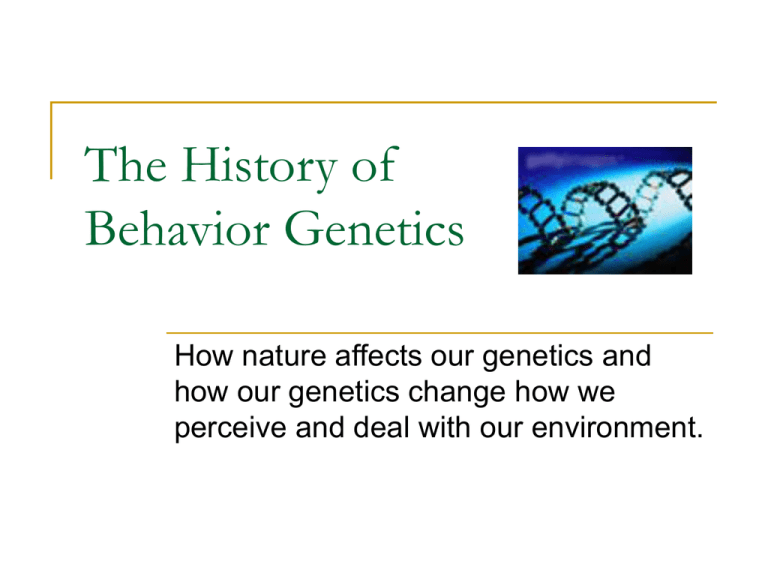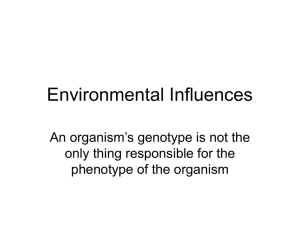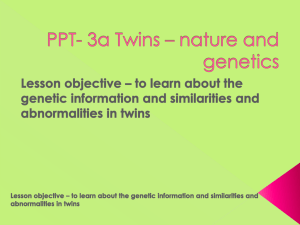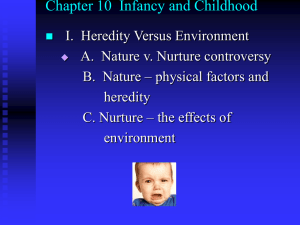
The History of
Behavior Genetics
How nature affects our genetics and
how our genetics change how we
perceive and deal with our environment.
Leaving evolutionary and entering
biological genetics…
Analogy:
evolutionary psychologists : universal
human tendencies
behavior geneticists : differences in one
another
What is the relationship?
Sir Francis Galton
Sir Francis Galton, inspired
by his cousin Darwin's Origin
of Species (1859), pioneered
the field of behavioral
genetics.
Galton believed all human
traits, including behavior, are
solely determined by genes,
without any contribution from
the environment.
Sir Francis Galton
Founder of Eugenics
This idea became the basis for
eugenics, a term Galton coined in
1883 to describe the use of genetics
for social planning.
Galton, in other words, believed that
selective "breeding" of the human
species could guarantee that the
"best" traits would remain in the
human population while the "worst"
traits could be eliminated.
Sir Francis Galton
Founder of Psychometrics
Psychometrics is the field of study
(connected to psychology and statistics)
concerned with the measurement of
"psychological" aspects of a person such as
knowledge, skills, abilities, or personality.
Critics, including "hard science" practitioners
and social activists, have argued that such
definition and quantification is impossibly
difficult and that such measurements are very
often misused.
This is What can Happen When Bad
People Hear Good Ideas
Based on Galton's ideas, the eugenics movement built
momentum in the United States, where between 1905 and
1933, several states based laws and legal decisions on
eugenics theory, and the federal government heavily restricted
immigration from Eastern and Southern Europe.
The Immigration Restriction Act of 1924 limited total immigration to
165,000 — about 15-20% of peak years. More important, it restricted
immigration from southern and eastern Europe countries to only 9% of
the total. Northern and western European countries were allotted 86%
of the quota, even though they made up the minority of immigrants in
1923. This change in the complexion of immigration was
accomplished by a cunning use of statistics.
The Johnson Act limited immigrants from each country according to
their proportion in the U.S. population in 1890 — a time prior to the
major waves of southern and eastern European immigration when the
U.S. was decidedly more Anglo-Nordic in composition.
This is What can Happen When Bad
People Hear Good Ideas
The goal was the production of a
genetically "pure" American
population.
During this time in American history,
criminals, people with low IQs and, in
some cases, even women who had
illegitimate children, were sterilized.
This is What can Happen When
Bad People Hear Good Ideas
During its time in power, the government
of Nazi Germany staunchly supported and
enforced the principles of eugenics.
Eugenics-based legislation culminated in
the "euthanasia" of the mentally retarded
and the physically disabled, who,
according to Nazi geneticists, would
otherwise contaminate the German people
with unfit genes.
This is What can Happen When Bad
People Hear Good Ideas
The list of genetic undesirables
ultimately grew to include Jews,
Gypsies, Communists, Catholics,
homosexuals, and political
opponents of the government.
During the 1930s and 1940s, a
large portion of the state's
resources funded a system of
death camps which, by the end of
World War II, exterminated nearly
twelve million people.
A Swing Back in the Other Direction
It was not until the 1980s that the scientific
community began to pay serious attention
to behavioral genetics as a science.
Using gene manipulation technologies
which had been in the works since the late
1960s, geneticists could finally map the
human genome itself.
A Swing Back in the Other Direction
Since the early ’80s,
geneticists have identified
genes for cystic fibrosis,
muscular dystrophy, and
Huntington's disease.
The successes in
identifying and mapping
human disease genes
have revitalized interest in
identifying genetic factors
underlying behavioral
traits.
What Behavior-Geneticists are Studying…
Twin and family studies,
genetic studies of animal
behavior, biochemical
investigations of
mutations, and the
development of new
molecular approaches,
have all added to the
momentum of the
modern search for genes
influencing behavior.
The Two Main Tools of a Behavior
Geneticist:
The Goal: Behavior Geneticists must try to
untangle the mystery between the influence
of genetics (nature) and the environment
(nurture).
The Tools:
Twin Studies
Adoption Studies
How Many Twins Are Out There
There are approximately 100 million twins
worldwide.
The twin birth rate for fraternal twins
varies slightly from country to country;
identical twin birth rates are pretty much
constant all over the world.
In Australia the twin birth rate is currently
about 1 set of twins for every 80 births;
there are a total of approx half a million
twins in Australia.
Types of Twins
Identical
twins
Fraternal
twins
Same
sex only
Same or
opposite sex
(Identical Twins) Monozygotic
twins develop when a single egg
is fertilized by a single sperm and
at some stage in the first two
weeks the developing embryo
splits in two, with the result that
two, GENETICALLY IDENTICAL
babies develop.
(Fraternal Twins) Dizygotic twins
occur when two separate eggs
are fertilized by two different
sperm. These two fertilized eggs
then develop independently.
Dizygotic twins share the same
type of genetic relationship as
non-twin siblings, hence the term
fraternal.
Environmental Influence
Two placental arrangements in identical twins
Do Twins Run In the Family?
A common question females ask is: "My mother
(or sister, aunt or grandmother) had twins, what
is the chance of me having twins too?"
Fraternal (dizygotic) twins do tend to run in
families. This is probably because there are
genetic influences which make multiple
ovulation more likely. There is no medical
evidence of identical twins running in the family
however there is some anecdotal evidence in
support of it. Women who conceive when they
are over 30 years of age also have an increased
chance of having twins.
Behavior Genetics
Vocabulary
Behavior Genetics
study of the power and limits of genetic and
environmental influences on behavior
Environment
every nongenetic influence, from prenatal
nutrition to the people and things around us
Behavior Genetics
Vocabulary
Temperament
a person’s characteristic emotional
reactivity and intensity
Heritability
the proportion of variation among
individuals that we can attribute to genes
may vary, depending on the range of
populations and environments studied
Behavior Genetics
Vocabulary
Interaction
the effect of one factor (such as
environment) depends on another factor
(such as heredity)
Molecular Genetics
the subfield of biology that studies the
molecular structure and function of genes










